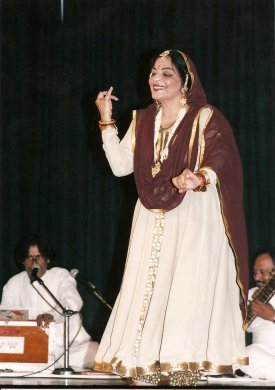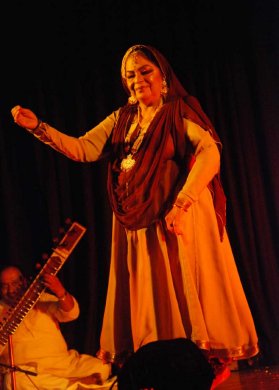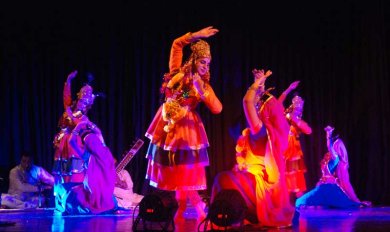
|   |

|   |
 e-mail: leelakaverivenkat@gmail.com On being one's own dancer Photos courtesy: Uma Sharma September 5, 2016 The year was 1964. Whenever one entered the office of the then Director of the Ashok Hotel Cultural Wing, late A.J. Jaspal, what arrested the visitor were three oversized photographs, dwarfing everything else in the area, of Yamini Krishnamurty, Sonal Mansingh and Uma Sharma - the three "prima donnas of Indian classical dance" as Jaspal described them. I was witness to Uma Sharma, at the time evolving as a sophisticated Kathak dancer for the proscenium, her artistry in abhinaya giving her an edge over other Kathak performers. I still recollect her performing to Surdas verses, describing the first meeting of young Krishna and Radha in Brindavan -"Bhoojat Sham, 'Kaun tu Gori?'" ("Who are you fair one?" asked Krishna). Thundering applause greeted the dancer's presentation of the item. I also remember Uma present the Meera bhajan, "Warwari Shyam tu wari, te ajo gulley hamari" in which Meera as virahotkhanthita not only pines for her Krishna calling out to him, but jealously attributes his absence to his whiling away the hours with another sakhi. Still ringing in the mind are the chants one heard of "Govind Hari bolo, Gopal Hari bolo", "Sundar Gopalam Uruvanamaalam", Krishna's description as he performs Raas "Angahi kotikaam chhabi lachate madnayak Giridhari", and phrases like "Morchandrika sirpar sohe" and "Jab Hari morjaise rumjhum nache" (all describing Krishna's beauty as he moved and danced). 
 I quote all this because today, half a century later, Uma is still performing these very items - nor does she seem to want to take up different themes like the rest of the Kathak world. Not for her the mad scramble of trying to be like other dancers, for she seems to have found herself, in what she is doing. At her age the old rhythmic virtuosity is replaced by a minimal expression in terms of footwork but with an ability which suggests all that, which due to time and its inevitabilities, has not been articulated. Watching Uma Sharma perform this Janmashtami evening at the IIC, the same repertoire, it was particularly towards the second half of the evening that I found the dancer really come into her own. I heard a person in the audience say, "Almost an anachronism today, her type of Kathak! But how does she still get a packed hall with a doting audience ecstatically swaying to her dance and the music?" Mubarak Ali on tabla, Khalid Mustafa on sitar and Jwala Prasad, the singer seemed beatific, as if having entered another space in their consciousness with their collective effort in creating the kind of music they have been, for years. Apart from her large circle of friends, a sprinkling of musicians and poets all middle aged, in the audience appeared star struck. I began asking myself, "Does performing the same items over a long time suggest a dancer who has never tried to reinvent herself as an artist?" I am reminded of Carnatic singers, rendering after forty years of performing, the same Tyagaraja kritis. One does not think of this as a stalemate for the singer's relationship with the kriti undergoes subtle changes over time. The item, one believes is only an excuse. It is what the artist is conveying through the item that is important. And 'newness' in Sampradaya art forms cannot be thought of as novelty, as much as an abstract something coming from an artist who in the constant negotiating with the particular item, is interacting with the soul of the art form. And in Uma's case, her subjectivity and persona recede into the background when she dances. One seeks neither rhythmic razzmatazz nor perfect geometry of lines and chakkars in her dance. Her totally unselfconscious sringar abhinaya as she interprets the poetry she is performing to, creates a definite nostalgia in many for the days of yore, when singing oneself (as Uma does) and performing the dance was the tradition.  Disregarding all performance protocol, she will suddenly, with a hand gesture to the musicians to completely soften the decibel level, walk up to the mike and start talking about Raskhan (the Muslim poet who became a great devotee of Krishna) whose poetry she has quoted on countless occasions "Chirachi chatak latak navakundalki." Taking up a phrase like "mujhe aakhan dikhaoge" ( are you going to make eyes at me), she will essay into a description and demonstration of how her Guru Shambhu Maharaj taught her abhinaya - always insisting that each glance of the eye should have the sharpness of an arrow hitting the target. And taking one word she will demonstrate myriad ways of using netrabhinaya. The whiff of the old style of Mujra, of which older people have very fond memories, is unconsciously evoked in Uma's performances. There is that quality in her dance where the dancer's physical beauty and even technique are unimportant in themselves. I remember a foreign western audience watching her dancing in a hotel in Dalhousie ten years ago, coming out with the remark from almost every quarter about 'the sensuous' quality of her dance. I also recollect our own scholar/critic V.A.K. Ranga Rao hearing Uma speak a few words from the stage on some occasion, remark that her sringar interpretation of poetry would perhaps take one back to the days of the devadasi - though he had never seen her perform! Uma has taken pains to go to the Raas gurus of Brindavan to learn the dance from them - the real Natawari Kathak. In between her solo appearances, her students in group, wearing the old frilled skirts perform selected segments of the Raas exactly as done even today in the Brindavan Sampradaya. "It was Kamaladevi Chattopadhyay who encouraged me to do research on this and told me never to change the old form. I can still see her sitting in the open air, on the moonlit night watching Brindavan Raas." It remains for Uma, an article of faith and homage to present Raas through her students every Janmashtami night and on the autumn night when Krishna is believed to have danced making every Gopi feel that she alone performed with Krishna as the partner.  Writing on the dance scene for the last forty years, Leela Venkataraman's incisive comments on performances of all dance forms, participation in dance discussions both in India and abroad, and as a regular contributor to Hindu Friday Review, journals like Sruti and Nartanam, makes her voice respected for its balanced critiquing. She is the author of several books like Indian Classical dance: Tradition in Transition, Classical Dance in India and Indian Classical dance: The Renaissance and Beyond. Post your comments Please provide your name and email id when you use the Anonymous profile in the blog to post a comment. All appropriate comments posted with name & email id in the blog will also be featured in the site. |